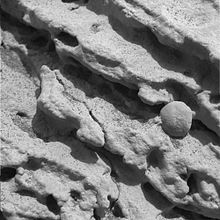- Martian spherules
-
Martian spherules (also known as blueberries due to their blue hue in false-color images released by NASA) are the abundant spherical hematite inclusions discovered by the Mars rover Opportunity at Meridiani Planum on the planet Mars. They are found in situ embedded in a sulfate salt evaporitic matrix, and also loose on the surface.
The shapes by themselves don't reveal the particles' origin with certainty. "A number of straightforward geological processes can yield round shapes," said Dr. Hap McSween, an Opportunity science team member from the University of Tennessee, Knoxville. They include accretion under water, but apparent pores in the particles make alternative possibilities of meteor impacts or volcanic eruptions more likely origins, he said.
For example, ranging in size from less than 100 micrometers to more than 250 micrometers, similar spherules were found in Moon soil samples collected by Apollo 12 at the Procellarum Basin, and Apollo 14 near Mare Imbrium (Sea of Rains), the dark crater that dominates the Moon's face, and their properties were consistent with expectations for creation by meteor impacts.
"We see these strange round objects we're calling "spherules" embedded in the outcrop, like blueberries in a muffin. The outcrop erodes away as it gets sandblasted, and the spherules (which seem to resist erosion better than the rest of the outcrop does) fall out and roll down the hill. Weird." said Dr. Steve Squyres. The spheres may have formed when molten rock was sprayed into the air by a volcano or a meteor impact. Or, they may be concretions, or accumulated material, formed by minerals coming out of solution as water diffused through rock, he said on a February 9 press conference.
Not only are there spherules on the surface but they are also found deeper in the Martian soil. The difference between these and ones which were found at the surface was that they had a very shiny surface, that created strong glints and glares which made them appear shiny or polished. On March 2, Opportunity mission scientists reported that they concluded a survey of the distribution of spherules in the bedrock. They found that the spherules spread out evenly and randomly inside the rocks, and not in layers. This supports the notion that they grew in place, since if their origin was related to volcanic or meteoric episodes one would expect layers of spherules as a "record in time" for each event. This observation was added to the list of evidence for liquid water being present at this rock site, where it is thought the spherules formed.
See also
External links
- Science Magazine special issue on MER Opportunity initial results
- Press releases from JPL relating to Mars spherules: Initial press release, composition results
- Morphological Investigations of Martian Spherules, Comparisons to Collected Terrestrial Counterparts. Full text PDF.
- Sedimentary Concretions vs. Impact Condensates: Origin of the Hematitic Spherules of Meridiani Planum, Mars. Full text PDF.
- Ironstone Concretions - Analogs to Martian Hematite Spherules. Full text PDF.
- Moqui Marbles relations to Martian Spherules.
- ScienceDaily.com on Moqui marbles and Martian spherules
- [1] relations to cyanobacteria and terrestrial stromatolites.
Mars Areography General- Observation history
- Albedo features (Solis Lacus)
- Atmosphere
- Canals (list)
- Climate
- Color
- Water
- Glaciers
- Life
- North Polar Basin
- Chaos terrain
- Noachian
- Soil
Regions- Alba Mons
- Albor Tholus
- Arsia Mons
- Ascraeus Mons
- Biblis Tholus
- Elysium Mons
- Hecates Tholus
- Olympus Mons
- Pavonis Mons
- Syrtis Major Planum
- Tharsis
- Tharsis Montes
- North Polar Basin
- Hellas Planitia
- Argyre Planitia
- Schiaparelli
- Gusev
- Eberswalde
- Bonneville
- Eagle
- Endeavour
- Endurance
- Erebus
- Victoria
- Gale
- Galle
- Ibragimov
- Santa Maria
- Valles
- Chasmata
- Outflow channel
- Valles Marineris
Moons Specific- Phobos
- (Features
- Stickney crater
- Monolith)
- Deimos
- (Features)
CommonExploration Past and
CurrentFutureAstronomy EclipsesAsteroidsMeteorites Other topics - Darian calendar
- Timekeeping on Mars
- Flag of Mars
- In Fiction
- Martian
- Mars Society
- (FMARS
- MDRS)
- Mars Institute
- (Haughton–Mars Project)
- Mythology
- Ocean Hypothesis
Categories:- Mars
- Rocks on Mars
Wikimedia Foundation. 2010.



